法律英语侵权法
- 格式:pptx
- 大小:633.68 KB
- 文档页数:52
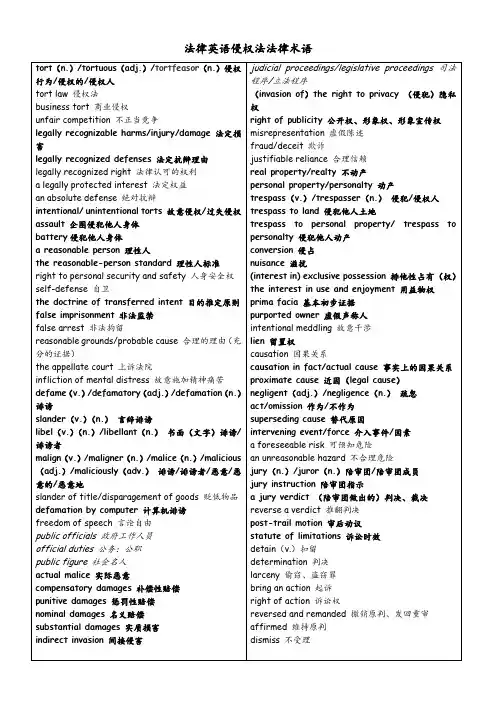
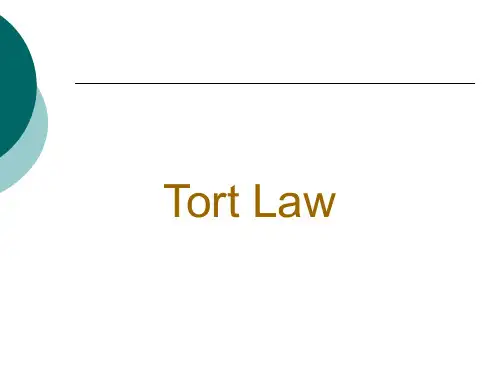
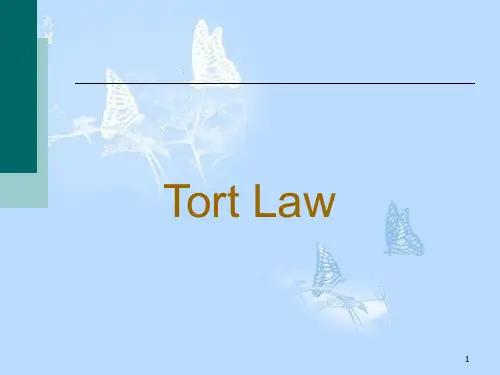
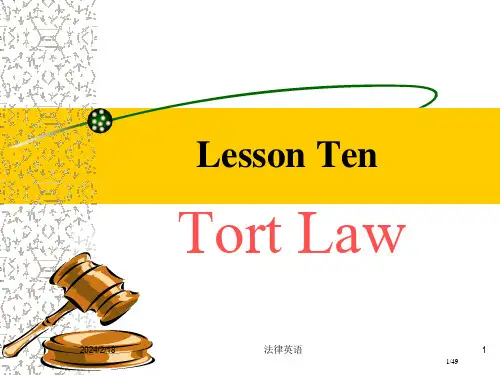
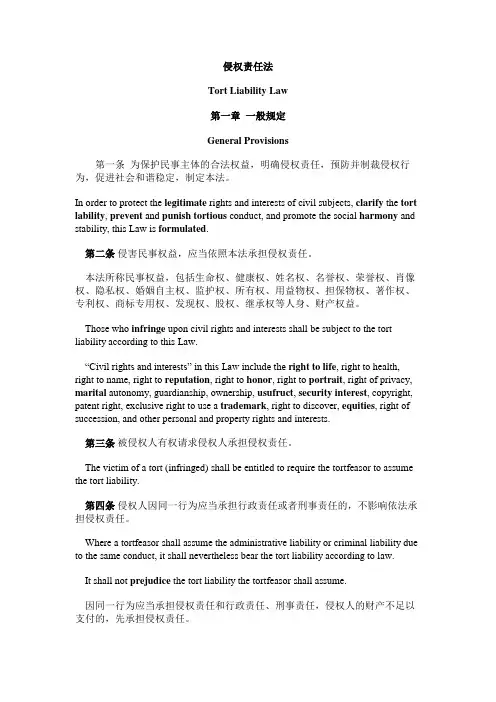
侵权责任法Tort Liability Law第一章一般规定General Provisions第一条为保护民事主体的合法权益,明确侵权责任,预防并制裁侵权行为,促进社会和谐稳定,制定本法。
In order to protect the legitimate rights and interests of civil subjects, clarify the tort lability, prevent and punishtortious conduct, and promote the social harmony and stability, this Law is formulated.第二条侵害民事权益,应当依照本法承担侵权责任。
本法所称民事权益,包括生命权、健康权、姓名权、名誉权、荣誉权、肖像权、隐私权、婚姻自主权、监护权、所有权、用益物权、担保物权、著作权、专利权、商标专用权、发现权、股权、继承权等人身、财产权益。
Those who infringe upon civil rights and interests shall be subject to the tort liability according to this Law.“Civil rights and interests” in this Law include the right to life, right to health, right to name, right to reputation, right to honor, right to portrait, right of privacy, marital autonomy, guardianship, ownership, usufruct, security interest, copyright, patent right, exclusive right to use a trademark, right to discover, equities, right of succession, and other personal and property rights and interests.第三条被侵权人有权请求侵权人承担侵权责任。
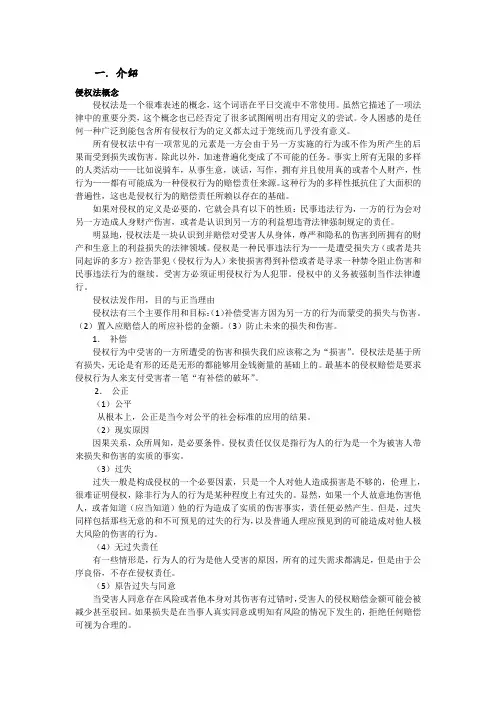
一.介绍侵权法概念侵权法是一个很难表述的概念,这个词语在平日交流中不常使用。
虽然它描述了一项法律中的重要分类,这个概念也已经否定了很多试图阐明出有用定义的尝试。
令人困惑的是任何一种广泛到能包含所有侵权行为的定义都太过于笼统而几乎没有意义。
所有侵权法中有一项常见的元素是一方会由于另一方实施的行为或不作为所产生的后果而受到损失或伤害。
除此以外,加速普遍化变成了不可能的任务。
事实上所有无限的多样的人类活动——比如说骑车,从事生意,谈话,写作,拥有并且使用真的或者个人财产,性行为——都有可能成为一种侵权行为的赔偿责任来源。
这种行为的多样性抵抗住了大面积的普遍性,这也是侵权行为的赔偿责任所赖以存在的基础。
如果对侵权的定义是必要的,它就会具有以下的性质:民事违法行为,一方的行为会对另一方造成人身财产伤害,或者是认识到另一方的利益想违背法律强制规定的责任。
明显地,侵权法是一块认识到并赔偿对受害人从身体,尊严和隐私的伤害到所拥有的财产和生意上的利益损失的法律领域。
侵权是一种民事违法行为——是遭受损失方(或者是共同起诉的多方)控告罪犯(侵权行为人)来使损害得到补偿或者是寻求一种禁令阻止伤害和民事违法行为的继续。
受害方必须证明侵权行为人犯罪。
侵权中的义务被强制当作法律遵行。
侵权法发作用,目的与正当理由侵权法有三个主要作用和目标:(1)补偿受害方因为另一方的行为而蒙受的损失与伤害。
(2)置入应赔偿人的所应补偿的金额。
(3)防止未来的损失和伤害。
1.补偿侵权行为中受害的一方所遭受的伤害和损失我们应该称之为“损害”。
侵权法是基于所有损失,无论是有形的还是无形的都能够用金钱衡量的基础上的。
最基本的侵权赔偿是要求侵权行为人来支付受害者一笔“有补偿的破坏”。
2.公正(1)公平从根本上,公正是当今对公平的社会标准的应用的结果。
(2)现实原因因果关系,众所周知,是必要条件。
侵权责任仅仅是指行为人的行为是一个为被害人带来损失和伤害的实质的事实。
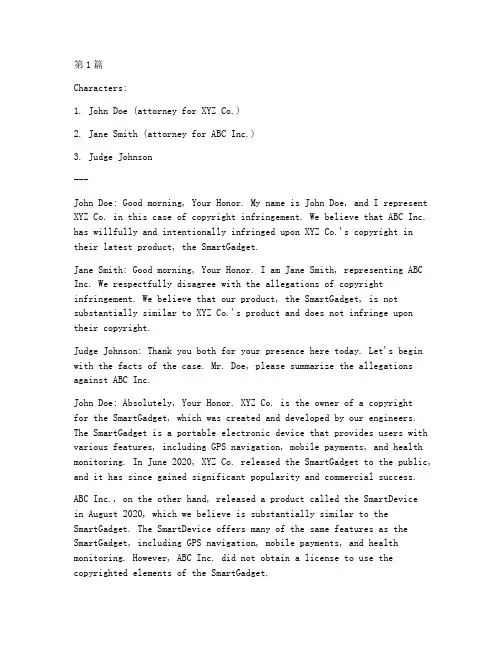
第1篇Characters:1. John Doe (attorney for XYZ Co.)2. Jane Smith (attorney for ABC Inc.)3. Judge Johnson---John Doe: Good morning, Your Honor. My name is John Doe, and I represent XYZ Co. in this case of copyright infringement. We believe that ABC Inc. has willfully and intentionally infringed upon XYZ Co.'s copyright in their latest product, the SmartGadget.Jane Smith: Good morning, Your Honor. I am Jane Smith, representing ABC Inc. We respectfully disagree with the allegations of copyright infringement. We believe that our product, the SmartGadget, is not substantially similar to XYZ Co.'s product and does not infringe upon their copyright.Judge Johnson: Thank you both for your presence here today. Let's begin with the facts of the case. Mr. Doe, please summarize the allegations against ABC Inc.John Doe: Absolutely, Your Honor. XYZ Co. is the owner of a copyrightfor the SmartGadget, which was created and developed by our engineers. The SmartGadget is a portable electronic device that provides users with various features, including GPS navigation, mobile payments, and health monitoring. In June 2020, XYZ Co. released the SmartGadget to the public, and it has since gained significant popularity and commercial success.ABC Inc., on the other hand, released a product called the SmartDevicein August 2020, which we believe is substantially similar to the SmartGadget. The SmartDevice offers many of the same features as the SmartGadget, including GPS navigation, mobile payments, and health monitoring. However, ABC Inc. did not obtain a license to use the copyrighted elements of the SmartGadget.Jane Smith: Your Honor, we respectfully disagree with the assertion that the SmartDevice is substantially similar to the SmartGadget. While both products share some features, the overall design, functionality, and user interface of the SmartDevice are distinct and unique. We have conducted a thorough investigation, and we can provide evidence to support our position.Judge Johnson: I appreciate your input, Ms. Smith. Mr. Doe, how does XYZ Co. establish that the SmartDevice infringes upon their copyright?John Doe: Your Honor, we have presented evidence that demonstrates the substantial similarity between the SmartGadget and the SmartDevice. This evidence includes a side-by-side comparison of the two products, which shows that they share a strikingly similar design, functionality, and user interface. Additionally, we have gathered testimonies from experts in the field who confirm that the SmartDevice is a direct copy of the SmartGadget.Jane Smith: Your Honor, while we understand the concerns of XYZ Co., we believe that the similarity between the two products is merely coincidental. Our company has always been committed to innovation and creating unique products. We have also conducted a thoroughinvestigation and have evidence to show that our engineers developed the SmartDevice independently, without any knowledge of the SmartGadget.Judge Johnson: Thank you, both counsel. Let's delve deeper into the similarities between the two products. Mr. Doe, please provide adetailed comparison of the SmartGadget and the SmartDevice.John Doe: Of course, Your Honor. We have identified several key similarities between the SmartGadget and the SmartDevice:1. Design: Both products have a sleek, modern design with a similar color scheme and button placement. The overall look and feel of the SmartDevice is almost identical to the SmartGadget.2. Functionality: Both devices offer GPS navigation, mobile payments, and health monitoring features. The layout and user interface for these features are nearly identical in both products.3. User Interface: The SmartDevice's user interface is almost a direct copy of the SmartGadget's user interface. The icons, menu options, and navigation paths are all very similar.4. Branding: The SmartDevice bears a striking resemblance to the SmartGadget's branding, including the logo, typography, and color scheme.Jane Smith: Your Honor, while we acknowledge some similarities, we believe that these are not enough to establish copyright infringement. We have evidence to show that our engineers developed the SmartDevice independently, without any knowledge of the SmartGadget. Furthermore, we have presented expert testimonies to support our position.Judge Johnson: I appreciate your arguments, Ms. Smith. However, the substantial similarity between the two products is a matter of concern. In order to determine whether copyright infringement has occurred, we must consider the following factors:1. Originality: Does the SmartGadget have originality?2. Access: Did ABC Inc. have access to the SmartGadget's copyrighted elements?3. Substantial Similarity: Is the SmartDevice substantially similar to the SmartGadget?4. Intent: Did ABC Inc. intend to infringe upon XYZ Co.'s copyright?John Doe: Your Honor, based on the evidence we have presented, we believe that the SmartGadget meets the criteria for originality. It is a unique product with distinct features and design elements. Additionally, ABC Inc. had access to the SmartGadget's copyrighted elements as it was publicly available when the SmartDevice was developed. The substantial similarity between the two products is evident from our comparison, and we believe that ABC Inc. intended to infringe upon our client's copyright.Jane Smith: Your Honor, we respectfully disagree with the claim of intent. We have evidence to show that our engineers developed the SmartDevice independently, without any knowledge of the SmartGadget.Furthermore, we have presented expert testimonies to support our position.Judge Johnson: After carefully considering the arguments and evidence presented by both parties, I find that XYZ Co. has established a prima facie case of copyright infringement against ABC Inc. While I acknowledge that some similarities exist between the SmartGadget and the SmartDevice, I believe that the substantial similarity between the two products is enough to support a finding of infringement.Therefore, I order ABC Inc. to cease and desist from manufacturing, distributing, or selling the SmartDevice. Additionally, XYZ Co. is entitled to damages for the infringement, which will be determined at a later hearing.John Doe: Thank you, Your Honor. We appreciate your decision.Jane Smith: We respectfully disagree with the decision, but we will comply with the court's orders.Judge Johnson: This concludes the hearing. Good day to both of you.---The above dialogue provides a simplified representation of a legal English copyright infringement case. In reality, the process would involve more detailed evidence, expert testimonies, and legal arguments.第2篇Court: United States District Court for the Southern District of New YorkDate: March 15, 2023Attorneys:- For the Plaintiff (Smith): Robert Thompson, Esq.- For the Defendant (Johnson): Emily Davis, Esq.---Judge: Thank you, Counsel. Let's proceed with the opening statements.Robert Thompson (Plaintiff's Attorney): Good morning, Your Honor. My client, Mr. Smith, is here today to seek redress for copyright infringement. On May 1, 2022, Mr. Johnson released a novel titled "Echoes of Time," which Mr. Smith believes infringes upon his own copyrighted work, "Chronicles of the Future," which was published in 2019.Emily Davis (Defendant's Attorney): Good morning, Your Honor. We respectfully disagree with the plaintiff's claim. "Echoes of Time" is an original work with no substantial similarity to "Chronicles of the Future." The alleged infringement is merely a coincidence, and the defendant did not copy any part of the plaintiff's work.Judge: Thank you, Counsel. Let's move on to the pre-trial motions. Have either party filed any motions that the court should consider?Robert Thompson: Yes, Your Honor. We have filed a motion for summary judgment, arguing that there is no genuine issue of material fact and that the defendant's work is a verbatim copy of our client's copyrighted material.Emily Davis: We have also filed a motion for summary judgment, arguing that the plaintiff's work is not copyrightable due to lack of originality, and that even if it were, there is no substantialsimilarity between the two works.Judge: Thank you, Counsel. The court will consider both motions and rule on them before the trial. Now, let's move on to the discovery phase. Have either party identified any relevant documents or witnesses?Robert Thompson: Yes, Your Honor. We have identified several witnesses, including the plaintiff himself, who can testify about the similarities between the two works. Additionally, we have discovered several internal documents from the defendant's publisher that suggest he was aware of our client's work prior to publication.Emily Davis: We have also identified relevant documents, including the defendant's own notes and research materials. However, we dispute the relevance of these documents and argue that they do not support the plaintiff's claim.Judge: The court will review the relevance and admissibility of these documents. Moving on to the trial, Counsel, please present your opening statements.Robert Thompson: Thank you, Your Honor. As I mentioned earlier, Mr. Smith's novel, "Chronicles of the Future," is a copyrighted work that tells the story of a futuristic civilization and its struggles with time travel. The novel is filled with unique characters, complex plotlines, and original ideas.Emily Davis: That is true, Your Honor. However, "Echoes of Time" is a standalone novel that explores a different genre entirely. It is a science fiction thriller about a group of scientists who discover a way to manipulate time and use it to their advantage. The works are fundamentally different in their themes and execution.Robert Thompson: Yet, the similarities are striking. The protagonist of "Echoes of Time," Dr. Michael Carter, shares a striking resemblance to Mr. Smith's protagonist, Dr. Ethan Winters. The premise of time manipulation is central to both novels, and the characters' personal struggles and motivations are eerily similar.Emily Davis: That is a matter of opinion, Mr. Thompson. The characters are developed independently, and the premise of time manipulation is a common theme in science fiction literature. The defendant's work is not a verbatim copy of "Chronicles of the Future."Robert Thompson: But the evidence shows otherwise. Our expert witness, Dr. Helen Taylor, a professor of literature, has compared the two works and concluded that they share a substantial amount of protectable expression. She has identified numerous direct and indirect quotations from "Chronicles of the Future" that appear in "Echoes of Time."Emily Davis: Dr. Taylor's conclusions are flawed. She has failed to consider the transformative nature of the defendant's work. "Echoes of Time" builds upon the plaintiff's novel but adds new elements and perspectives. It is not a derivative work, as the plaintiff claims.Robert Thompson: The defendant's claim of originality is a red herring. The similarities in plot, character, and setting are too great to be mere coincidence. The defendant must have had access to "Chronicles of the Future" and copied its protected elements.Emily Davis: Access is not a requirement for copyright infringement. Moreover, the plaintiff's work is not original. The concept of timetravel is not protected by copyright, and the plaintiff has not demonstrated that his work contains any original elements.Robert Thompson: We have. The unique narrative structure of "Chronicles of the Future," the depth of the characters' development, and the originality of the thematic elements are all protected by copyright law.Emily Davis: The court must consider the totality of the circumstances. The defendant's work, while inspired by the plaintiff's novel, is a new and distinct creation. The similarities are superficial and do not rise to the level of copyright infringement.---Judge: Thank you, Counsel. The court has heard your arguments. The trial will proceed with the presentation of evidence and witness testimony. Both parties are reminded to adhere to the rules of evidence and tofocus on the relevant issues in this case.---[The trial continues with the presentation of evidence, expert testimony, and witness statements. After several days of testimony, the court will issue a decision.]Judge: After careful consideration of the evidence and arguments presented, the court finds that there is substantial similarity between the plaintiff's copyrighted work, "Chronicles of the Future," and thedefendant's novel, "Echoes of Time." The defendant's work is not transformative and does not provide a new interpretation of theplaintiff's original ideas. Therefore, the court holds that the defendant's work constitutes copyright infringement.Emily Davis (Defendant's Attorney): We respectfully disagree with the court's decision and will file an appeal.Robert Thompson (Plaintiff's Attorney): We are satisfied with thecourt's decision and will seek appropriate remedies, including damages and an injunction to prevent further infringement.Judge: The court will issue its final judgment within the next few weeks. Thank you, Counsel, for your attention to this matter.---End of Case Dialogue第3篇Court: Superior Court of New York, County of ManhattanDate: January 15, 2023Jurisdiction: New YorkPlaintiff: John Smith, Esq. (on behalf of himself and as an agent forthe copyright holders)Defendant: Jane JohnsonCounsel for Plaintiff: Robert Brown, Esq.Counsel for Defendant: Lisa White, Esq.---The Honorable Judge John Doe:The Court: Good morning, Counsel. Please call the case to order.Robert Brown, Esq. (Plaintiff's Counsel):Mr. Brown: Thank you, Your Honor. May it please the Court, I call this case Smith v. Johnson. My client, John Smith, is the plaintiff and represents himself as an agent for the copyright holders. We are here today to bring forth a claim of copyright infringement against the defendant, Jane Johnson.Lisa White, Esq. (Defendant's Counsel):Ms. White: Yes, Your Honor. I represent Jane Johnson, the defendant. I acknowledge the plaintiff's claim of copyright infringement and look forward to presenting our defense.The Honorable Judge John Doe:The Court: Thank you, Counsel. Mr. Brown, please proceed with your opening statement.Robert Brown, Esq. (Plaintiff's Counsel):Mr. Brown: Thank you, Your Honor. In this case, the plaintiff, John Smith, is a renowned author of historical fiction. He has written a novel titled "The Legacy of Time," which was published in 2018. The novel is protected by United States copyright law.The Honorable Judge John Doe:The Court: And how does the defendant come into this case?Robert Brown, Esq. (Plaintiff's Counsel):Mr. Brown: Your Honor, the defendant, Jane Johnson, is a self-published author. In 2020, she released her novel, "Echoes of the Past," which is substantially similar to Mr. Smith's work, "The Legacy of Time." This similarity is not due to any legitimate research or independent creation on her part.The Honorable Judge John Doe:The Court: Is there evidence of direct copying or similarity between the two works?Robert Brown, Esq. (Plaintiff's Counsel):Mr. Brown: Yes, Your Honor. We have presented several exhibits to the Court that show the similarity between the plot, characters, and significant portions of the text from both novels. Our expert witness, Dr. Emily Green, a literary scholar, has also analyzed the works and confirmed the substantial similarity.Lisa White, Esq. (Defendant's Counsel):Ms. White: Your Honor, I object to the introduction of this expert testimony. The plaintiff has not provided sufficient foundation for Dr. Green's qualifications as an expert in literary analysis. Additionally, the methodology she used is flawed and subjective.The Honorable Judge John Doe:The Court: Sustained. Counsel, we will allow the expert testimony, but it will be subject to rigorous cross-examination. Please proceed with your opening statement, Mr. Brown.Robert Brown, Esq. (Plaintiff's Counsel):Mr. Brown: Thank you, Your Honor. Dr. Green's analysis is based on the literary analysis of the works and the principles of copyright law. She has compared various elements of the two novels, including the plot, character development, and thematic elements.The Honorable Judge John Doe:The Court: What is the nature of the infringement, Mr. Brown?Robert Brown, Esq. (Plaintiff's Counsel):Mr. Brown: The infringement is clear, Your Honor. The defendant's novel, "Echoes of the Past," has been copied from my client's work, "The Legacy of Time," without permission. This constitutes a violation of the plaintiff's exclusive rights under the Copyright Act of 1976.Lisa White, Esq. (Defendant's Counsel):Ms. White: Your Honor, my client did not copy the work. She claims that her novel was inspired by the themes of time travel and historicalevents, which are not original to the plaintiff's work. Furthermore, the defendant's novel contains significant differences in style andnarrative structure.The Honorable Judge John Doe:The Court: And how does the defendant respond to the claim ofsubstantial similarity?Lisa White, Esq. (Defendant's Counsel):Ms. White: We argue that the themes of time travel and historical events are common in the genre of historical fiction and cannot be protected by copyright. Additionally, our expert, Dr. Michael Thompson, a literary critic, will testify that the defendant's novel is not substantially similar to the plaintiff's work.The Honorable Judge John Doe:The Court: Thank you, Counsel. We will hear from Dr. Thompson next. Mr. Brown, do you wish to call your expert witness, Dr. Green, to the stand?Robert Brown, Esq. (Plaintiff's Counsel):Mr. Brown: Yes, Your Honor. We will call Dr. Emily Green to the stand.---Dr. Emily Green (Expert Witness for the Plaintiff):Dr. Green: Thank you, Counsel. I am Dr. Emily Green, a professor of English literature with a focus on copyright law and literary analysis.I have reviewed the works of the plaintiff and the defendant and can confirm that there is a substantial similarity between the two novels.Lisa White, Esq. (Defendant's Counsel):Ms. White: Dr. Green, are you qualified to offer an opinion on the issue of substantial similarity?Dr. Green: Yes, I am qualified. I have extensive experience in analyzing literary works for copyright purposes.Lisa White, Esq. (Defendant's Counsel):Ms. White: Dr. Green, how do you define "substantial similarity"?Dr. Green: Substantial similarity refers to the extent to which two works share common elements, such as plot, characters, dialogue, and setting. If a substantial number of these elements are similar, the works are substantially similar.Lisa White, Esq. (Defendant's Counsel):Ms. White: Dr. Green, how did you arrive at your conclusion that the works are substantially similar?Dr. Green: I compared the two novels in detail, looking at various elements. For example, the main characters in both novels are time travelers who are involved in historical events. The narrative structure and some of the dialogue are also similar.Lisa White, Esq. (Defendant's Counsel):Ms. White: Dr. Green, are you aware that the themes of time travel and historical events are common in the genre of historical fiction?Dr. Green: Yes, I am aware of that. However, the specific way in which these themes are presented in the plaintiff's novel is original and unique. The defendant's novel shares many of these elements, indicating that there was copying.---The hearing continues with the examination of other witnesses, the presentation of additional evidence, and the cross-examination of both experts. The case is set for trial, and the Court will make a decision based on the evidence presented.。
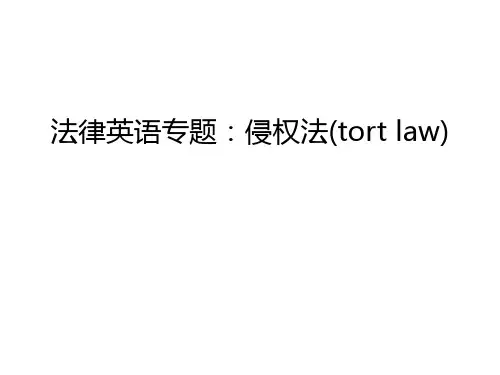
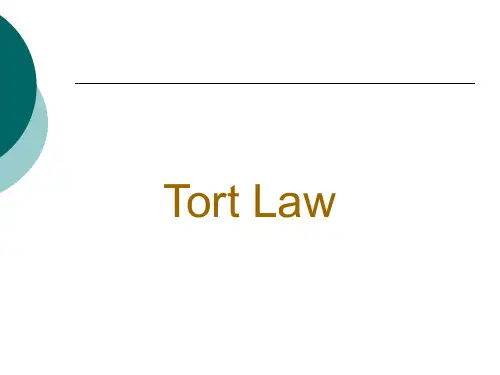
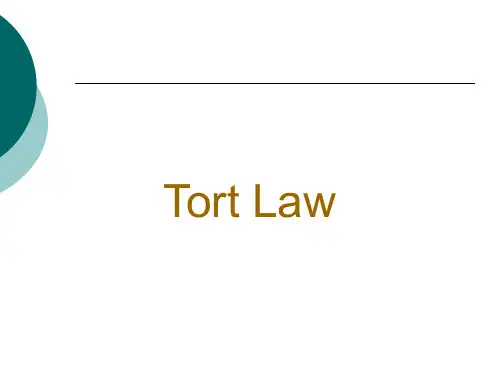
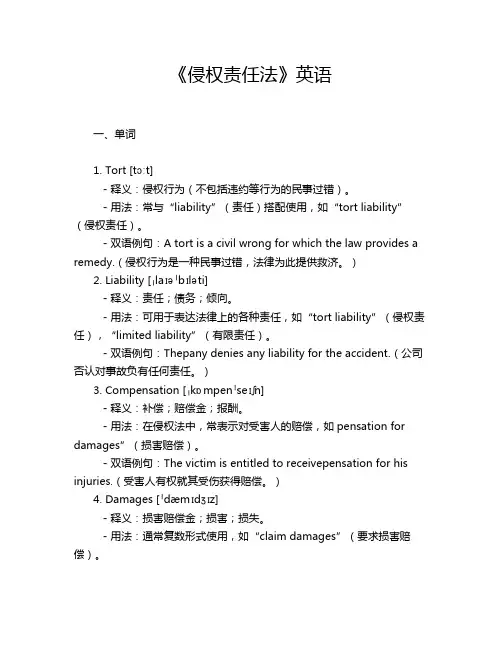
《侵权责任法》英语一、单词1. Tort [tɔːt]- 释义:侵权行为(不包括违约等行为的民事过错)。
- 用法:常与“liability”(责任)搭配使用,如“tort liability”(侵权责任)。
- 双语例句:A tort is a civil wrong for which the law provides a remedy.(侵权行为是一种民事过错,法律为此提供救济。
)2. Liability [ˌlaɪəˈbɪləti]- 释义:责任;债务;倾向。
- 用法:可用于表达法律上的各种责任,如“tort liability”(侵权责任),“limited liability”(有限责任)。
- 双语例句:Thepany denies any liability for the accident.(公司否认对事故负有任何责任。
)3. Compensation [ˌkɒmpenˈseɪʃn]- 释义:补偿;赔偿金;报酬。
- 用法:在侵权法中,常表示对受害人的赔偿,如pensation for damages”(损害赔偿)。
- 双语例句:The victim is entitled to receivepensation for his injuries.(受害人有权就其受伤获得赔偿。
)4. Damages [ˈdæmɪdʒɪz]- 释义:损害赔偿金;损害;损失。
- 用法:通常复数形式使用,如“claim damages”(要求损害赔偿)。
- 双语例句:The court awarded him substantial damages.(法院判给他巨额损害赔偿金。
)5. Negligence [ˈneɡlɪdʒəns]- 释义:疏忽;过失;粗心大意。
- 用法:是侵权责任的一个重要概念,如“negligence liability”(过失责任)。
- 双语例句:The accident was caused by his negligence.(事故是由他的疏忽造成的。
侵权责任法Tort Liability Law第一章一般规定General Provisions第一条为保护民事主体的合法权益,明确侵权责任,预防并制裁侵权行为,促进社会和谐稳定,制定本法。
In order to protect the legitimate rights and interests of civil subjects, clarify the tort lability, prevent and punishtortious conduct, and promote the social harmony and stability, this Law is formulated.第二条侵害民事权益,应当依照本法承担侵权责任。
本法所称民事权益,包括生命权、健康权、姓名权、名誉权、荣誉权、肖像权、隐私权、婚姻自主权、监护权、所有权、用益物权、担保物权、著作权、专利权、商标专用权、发现权、股权、继承权等人身、财产权益。
Those who infringe upon civil rights and interests shall be subject to the tort liability according to this Law.“Civil rights and interests” in this Law include the right to life, right to health, right to name, right to reputation, right to honor, right to portrait, right of privacy, marital autonomy, guardianship, ownership, usufruct, security interest, copyright, patent right, exclusive right to use a trademark, right to discover, equities, right of succession, and other personal and property rights and interests.第三条被侵权人有权请求侵权人承担侵权责任。
法律英语汉译英(专业词汇部分)Unit One第一课美国联邦下的法律1.成文法statutory law★2.普通法common law3.判例法case law4.立法机构legislature5.法院court6.宪法Constitution7.立法权law-making power8.私法private law9.合同法contract law10.侵权法tort law11.商法business law12.公司法corporate governance law13.专利和版权patent and copyright14.合同/契约争议contractual disputes15.刑事案件criminal case16.民事案件civil case17.民事侵权诉讼civil tort actions18.家庭法family law19.法律选择choice of law20.多个司法管辖区multi-jurisdiction21.诉讼litigation/lawsui t/suit/action★22.实体权substantive right23.准据法/适用法applicable/governing/proper law★24.签订conclude25.证券欺诈案件 a case include claims of securities fraud26.履行perform27.履行地performance28.受理/处理案件to hear the case★29.原告plaintiff★30.被告defendant★31.与合同最密切联系most involved with the contract32.选择法庭choice of forum第二课双重法院体系1.司法的judicial2.初审法庭trial court3.终审法院court of last resort★4.上诉法院court of appeals5.上诉,申诉appeal…to6.证人witness7.证据evidence8.陪审团jury9.查明事实的人,事实发现者fact-finder10.上诉的,有权受理上诉的appellate11.遗嘱probate12.小额诉讼法院small claims court13.律师attorney14.程序procedure15.提出(申请)file★16.申请小额索赔file claims for small sums of money17.定罪conviction★18.仲裁人,公断人,裁决人arbiter19.最高法院the Supreme Court20.先例procedureUnit Two第一课抗辩制1.上诉人appellant2.被上诉人appellee3.诉由,案由cause of action★4.向某人提起诉讼,到法院告某人to bring an action/lawsuit against sb.5.第三那人被告third-party defendant6.庭审程序trial procedure★7.英美法系国家的司法程序Anglo-American judicial procedure8.认定事实find the fact9.证据submission10.抗辩制adversary system11.提起诉讼begin suit12.界定争议shape the issues13.出示证据produce evidence14.争议当事人parties to the controversy15.纠问的inquisitorial16.庭前调查pre-trial investigation17.大陆法传统civil law tradition18.庭辩风格style of presentation and argument19.有利害关系的当事人interested parties第二课开启一个诉讼1.起诉sue2.诉讼当事人litigant3.司法救济,救济;减轻,缓解relief4.提供法律救助to furnish a relief5.纠正,补偿redress6.诉诸法院bring to court★7.和解settlement★8.仲裁arbitration9.自力救济self-help10.搁置纠纷let matters rest11.损害赔偿damages★12.实际履行specific performance13.对事管辖权jurisdiction over the subject matter14.对人管辖权jurisdiction over the parties15.管辖权jurisdiction16.违约之诉damages for breach of contract17.法庭forum18.最低限度联系minimum contacts19.实体公正substantial justice20.审判地venue21.规定(援引法条)provide/read第三课诉状和对抗诉状的动议1.诉状pleading2.起诉状complaint3.向法院提交诉讼状或答辩状/办理立案to file a pleading/lawsuit with the court4.陈述,阐明to set forth5.书记员clerk6.传票summons7.出具传票to issue a summons8.向某人送达传票、起诉书、法律文书to serve a summons, complaint, legal document on sb.9.通知notify10.同意出庭an entry of appearance11.指控,声称allegation12.成为争议问题put in issue13.积极抗辩affirmative defense14.反诉counterclaim15.(用辩解)减轻extenuate16.未到庭,未履行义务to be in default17.驳回dismiss18.传票送达service of process/service of summons19.法律上的充分性legal sufficiency20. 提出异议,反对challenge第四课调查取证1.庭前取证,调查pre-trial discovery2.录取证词,宣誓证明depose3.证词笔录,书证deposition4.宣誓under oath5.书面质询written interrogatories6.人身伤害案件personal injury case7.保持中立take no part8.意外因素surprise element9.争议controversy10.律师counsel11.庭前会议pretrial conference12.即决判决,简易判决summary judgment13.书证,书面陈述affidavit14.提出请求即决判决的动议make a motion for summary judgment15.(证据)允许提出的,可采纳的admissible16.扰乱对方harassment of an opponent17.要求对争议进行庭审的申请notice of trial/issue第五课庭审1.主张…..权利assert the right to2.将……列入陪审员名单impanel3.组成陪审团to impanel the jury4.绝对异议权peremptory challenge★5.候选陪审员prospective juror6.以明确的理由对陪审员候选人提出异议to challenge a prospective juror for cause7.发誓swear8.开案陈词make opening statements9.询问证人examine the witness10.出示文书produce the document11.证据,物证exhibit12.直接质证direct examination13.交叉质证cross examination14.不允许出示的证据inadmissible evidence15.举证完毕rest16.指令裁定(法官指令陪审团作出的裁定)directed verdict17.否决,驳回overrule18.(法官)对陪审团的指导jury instruction/jury charge/charge to the jury19.结案辩论final argument20.判决某人胜诉to enter a judgment for sb.21.判决某人败诉to enter a judgment against sb.22.举证责任burden of proof23.有分量的证据,占优势的证据preponderance of the evidence24.退庭retire25.(陪审团)未能达到足够多数人赞同的,未能做出决定的hung26.法官推翻陪审团才定的判决judgment notwithstanding the verdict(judgment n.o.v)27.达成裁定reach verdict第六课上诉和执行1.执行enforcement2.复审review3.中级法院intermediate court4.初审法院trial court5.下级法院lower court6.斟酌,自由裁量discretion7.由……斟酌决定,由…..自由裁量at the discretion of8.推翻原判,逆转reverse9.维持原判,确认,确信affirm10.认定事实determination in question11.上诉担保书appeal bond12.抄本,复本,文字记录transcript13.命令decree14.(不服下级法官判决)进行上诉to appeal from (a decision of a lower court)15.口头辩论oral argument16.判决(意见)书opinion17.败诉方losing party18.债权人creditor19.重新审理rehear20.执行令writ of execution21.行政司法长官,县治安官sheriff22.发回重审remand23.动产personal property24.判决债务人judgment debtor25.收益proceeds26.不动产real estate/real property27.未清偿判决债务由司法行政官主持的拍卖judicial sale28.留置权,扣留权lien29.对…..有司法留置权to have a judicial lien on30.留置,扣押(动词)garnish31.留置,扣押(名词)garnishment32.扣押(动词)attach33.扣押(名词)attachment。